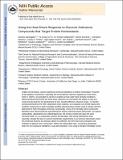| dc.contributor.author | Santagata, Sandro | |
| dc.contributor.author | Xu, Ya-ming | |
| dc.contributor.author | Wijeratne, E. M. Kithsiri | |
| dc.contributor.author | Kontnik, Renee | |
| dc.contributor.author | Rooney, Christine | |
| dc.contributor.author | Perley, Casey C. | |
| dc.contributor.author | Kwon, Hyoungtae | |
| dc.contributor.author | Clardy, Jon | |
| dc.contributor.author | Kesari, Santosh | |
| dc.contributor.author | Whitesell, Luke | |
| dc.contributor.author | Lindquist, Susan | |
| dc.contributor.author | Gunatilaka, A. A. Leslie | |
| dc.date.accessioned | 2013-11-04T14:45:36Z | |
| dc.date.available | 2013-11-04T14:45:36Z | |
| dc.date.issued | 2011-11 | |
| dc.date.submitted | 2011-09 | |
| dc.identifier.issn | 1554-8929 | |
| dc.identifier.issn | 1554-8937 | |
| dc.identifier.uri | http://hdl.handle.net/1721.1/81963 | |
| dc.description.abstract | Unlike normal tissues, cancers experience profound alterations in protein homeostasis. Powerful innate adaptive mechanisms, especially the transcriptional response regulated by Heat Shock Factor 1 (HSF1), are activated in cancers to enable survival under these stressful conditions. Natural products that further tax these stress responses can overwhelm the ability to cope and could provide leads for the development of new, broadly effective anticancer drugs. To identify compounds that drive the HSF1-dependent stress response, we evaluated over 80,000 natural and synthetic compounds as well as partially purified natural product extracts using a reporter cell line optimized for high-throughput screening. Surprisingly, many of the strongly active compounds identified were natural products representing five diverse chemical classes (limonoids, curvularins, withanolides, celastraloids, and colletofragarones). All of these compounds share the same chemical motif, an α,β-unsaturated carbonyl functionality, with strong potential for thiol-reactivity. Despite the lack of a priori mechanistic requirements in our primary phenotypic screen, this motif was found to be necessary albeit not sufficient, for both heat-shock activation and inhibition of glioma tumor cell growth. Within the withanolide class, a promising therapeutic index for the compound withaferin A was demonstrated in vivo using a stringent orthotopic human glioma xenograft model in mice. Our findings reveal that diverse organisms elaborate structurally complex thiol-reactive metabolites that act on the stress responses of heterologous organisms including humans. From a chemical biology perspective, they define a robust approach for discovering candidate compounds that target the malignant phenotype by disrupting protein homeostasis. | en_US |
| dc.language.iso | en_US | |
| dc.publisher | American Chemical Society (ACS) | en_US |
| dc.relation.isversionof | http://dx.doi.org/10.1021/cb200353m | en_US |
| dc.rights | Article is made available in accordance with the publisher's policy and may be subject to US copyright law. Please refer to the publisher's site for terms of use. | en_US |
| dc.source | PMC | en_US |
| dc.title | Using the Heat-Shock Response To Discover Anticancer Compounds that Target Protein Homeostasis | en_US |
| dc.type | Article | en_US |
| dc.identifier.citation | Santagata, Sandro, Ya-ming Xu, E. M. Kithsiri Wijeratne, Renee Kontnik, Christine Rooney, Casey C. Perley, Hyoungtae Kwon, et al. “Using the Heat-Shock Response To Discover Anticancer Compounds that Target Protein Homeostasis.” ACS Chemical Biology 7, no. 2 (February 17, 2012): 340-349. | en_US |
| dc.contributor.department | Massachusetts Institute of Technology. Department of Biology | en_US |
| dc.contributor.mitauthor | Lindquist, Susan | en_US |
| dc.contributor.mitauthor | Perley, Casey C. | en_US |
| dc.relation.journal | ACS Chemical Biology | en_US |
| dc.eprint.version | Author's final manuscript | en_US |
| dc.type.uri | http://purl.org/eprint/type/JournalArticle | en_US |
| eprint.status | http://purl.org/eprint/status/PeerReviewed | en_US |
| dspace.orderedauthors | Santagata, Sandro; Xu, Ya-ming; Wijeratne, E. M. Kithsiri; Kontnik, Renee; Rooney, Christine; Perley, Casey C.; Kwon, Hyoungtae; Clardy, Jon; Kesari, Santosh; Whitesell, Luke; Lindquist, Susan; Gunatilaka, A. A. Leslie | en_US |
| dc.identifier.orcid | https://orcid.org/0000-0003-1307-882X | |
| mit.license | PUBLISHER_POLICY | en_US |
| mit.metadata.status | Complete | |
